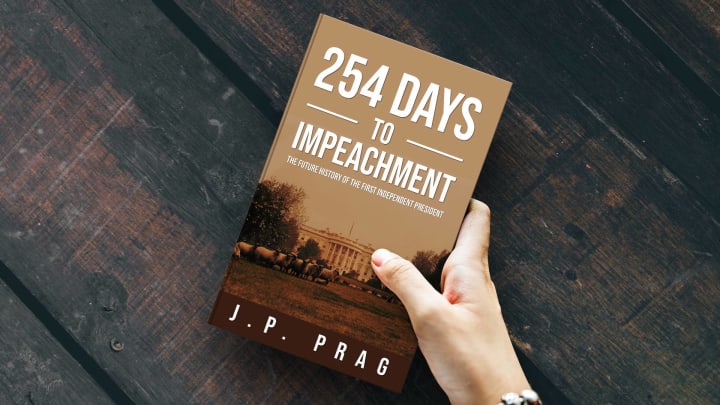
February 27th (Newport News, VA) – The President wants the country to focus in on five very specific scientific endeavors; ones that the administration says will tackle “the current real security problems and human toll due to climate change”, but will also set the United States up for a long-term future. By attempting to frame these issues both as “security” and “climate change”, the President seems to be hoping to woo enough Republicans and Democrats into supporting a common cause, even if it is for entirely different reasons.
During the State of the Union address, the President had already spent a good deal of time talking about healthcare yet was not done asking Congress to take more bold leaps. In this case, though, instead of trying to make massive changes across an entire embedded industry, the President expressed the need for America to concentrate its efforts on a few scant ideas that would make the most impact. The premise was definitively around environmentalism, for the most part, even though the last suggestion was for an elevator into space.
Water, Water Everywhere, Ne’er a Drop to Drink
At the top of the agenda was what the President called “Water Security”. By the Commander-in-Chief’s reasoning, there is enough water in the United States and the entire world, it is just distributed incorrectly. For instance, States like Florida are completely drenched in water and have already seen the dangers of coastal erosion and internal displacement related to rising sea levels as the ice caps have melted. Meanwhile, in southwest States like Arizona, being dependent upon water allocations from the Colorado River had proved impossible to maintain by the early 2020s as snowfall that fed the waterway dramatically decreased. Both of these issues, the President said, can be solved with the same solution: desalination plants and piping networks.
Desalination is the process of removing salt and other contaminants from ocean water and turning it into a potable form for human consumption and use. The President would like to see immense desalination plants built on the coasts—plants that would run solely on renewable sources—and pump that water to pools in the deserts and water-strapped areas of the United States. More so, the President would like to have this program expanded to overseas, even potentially creating the largest freshwater lake in the world in the middle of the Sahara Desert. Said the President:
The number one reason countries are and will be going to war is for control over resources, especially fresh water, the compound that is essential for all life. Now imagine just making water an abundant resource for a minor investment. And let’s do some basic math—which is more expensive: another endless war or stopping war before it even starts with a glass of H2O?
The President argued that this would kill not just two birds with one stone, but “a whole flock of them”. Desalination on a massive global scale would stop and reverse sea level rise, ending a potential refugee situation for the 40% of the world population that currently lives in the flood zones of the coast. At the same time, it would provide a much-needed supply of fresh water that is necessary for consumption and farming, creating food security in places that have not had it in all of modern human history. However, the President was not unaware of critics that say using desalination is dangerous and may pose a risk to ocean life. In response to those groups, the President stated:
We have several immediate and perilous difficulties we need to solve now. Because of that, there are going to be tradeoffs. We can work to mitigate those issues and maybe, someday in the future, we will be able to turn off the spigots. But we have to address the reality of the ongoing impacts of Climate Change first while we work towards having a future when these measures will no longer be needed. Unfortunately, that is a multi-generational affair, not something nearly quick enough to save mankind.
That said, the President did submit ideas that should be implemented along with this desalination program to address long-term concerns. Many of these were just expansions of successful programs seen in water-starved areas like California, Israel, the United Arab Emirates, and others that seemingly just “lacked the willpower” to be implemented around the country and the rest of the world. These included, but were not limited to:
- In agriculture, using recycled grey water (previously used water from things like showers and toilets that has been mildly treated) in direct drip irrigation instead of free spraying water from overhead;
- In reservoirs, rivers, and other water transports, covering them with solar panels to minimize evaporation while also generating electricity for the pumps;
- In the home, installing low-flow shower heads and faucets that make people feel like they are getting the same water pressure while actually cutting usage by up to 70%.
Again, the President recognized that the most hawkish proponents of addressing Climate Change head-on would want to modify behavior first to get people to take shorter showers, but the President found this approach unrealistic. To this, the President declared:
You have to meet people where they are and, realistically, this is where they are at.
It's Electric, Boogie Woogie, Woogie
This same idea of not waiting decades to change attitudes and actions carried through into the next area entitled “Energy Diversification”. Not unexpectedly, the President suggested a colossal expansion into solar, wind, wave, geothermal, and every other non-emitting energy source. To the surprise of many, though, the President stated a desire to not just build more nuclear power plants, but to actually recycle existing and future nuclear waste.
According to a 2022 study by the Idaho National Laboratory, at that time there was already enough nuclear waste left over from reactors “to power the entire country for 100 years.” Technology to do so is well known, having been vetted for over 30 years starting in the 1960s. Other nuclear powers like Russia also successfully implemented this technology and maintain it to this day. Congress in the past even supported one of these so-called “Fast Reactors” before shutting it down by eliminating funding due to the political pressures of that era.
The President sees that decision as an egregious mistake of a prior administration and wants to catch up on lost time and knowledge. That said, even if Congress were to fund the creation of these plants and somehow hope to find the economies of scale necessary to bring the price down enough for widespread commercial use later, that would still take years, if not decades. Since that type of plan would seemingly go against the urgency the President was portending, another strategy was needed for the here-and-now.
With this, the President said the best thing we could do is require every rooftop in America to be filled with solar panels and storage batteries. The President proposed a public-private partnership where real estate and home owners could choose to purchase the panels themselves and reap all the benefits of net metering (utility companies being forced to buy all the energy that is produced and sent into the grid); let a private company pay and create some type of revenue sharing and lease deal; or have the government do the installation under a program that would see the majority of benefits go directly to itself, at least until the government recouped its investment plus interest. As the President said:
If we have an overabundance of electricity, it will force prices down to the point where fossil fuels will not even be able to compete. Additionally, we need to have programs to turn all home and building HVAC systems into electric ones through rebates and discount installations, perhaps even up to 100%. In order to end our addiction to fossil fuels, the replacements must feel exactly the same and provide a noticeable benefit, otherwise people will continue to cling to old and unsustainable ways.
Baby, you can drive my car
Yet, when it comes to controlling emissions from burning fossil fuels, a significant factor had been left out of the discussion up to this point: automobiles. According to the formerly independent Environmental Protection Agency (EPA), nearly a sixth of all carbon-contribution comes directly from people driving around in their passenger and light-duty vehicles. If adding in the rest of “transportation”, that amount doubles.
The obvious solution that could be coupled with the President’s other plans would be to expand the availability of electric vehicles. This could be done by banning the building of new combustion engines after a certain time (as some States have attempted) and/or providing discount and trade-in tax rebates to accelerate the uptake of new vehicles that meet the necessary standards. And for sure, the President did recommend those very programs, but was less forceful than normal, saying there was another problem that needed to be handled first:
We have a cart-before-the-horse issue to resolve before any of that. Critics of an all-electric fleet will highlight that liquid fuels get better efficiencies on a miles-per-energy basis, and that a charging station takes far longer than just filling up. If charging is not at least as easy and convenient as filling up at the gas station, then consumers will not adopt the change to electric vehicles. We have already seen this in our prior attempts at expanding the electric-vehicle infrastructure.
The President then discussed the naysayers some more, going deeper into what had already been done:
Even when combining the impact from the Infrastructure Investment and Jobs Act of 2021 and the Inflation Reduction Act of 2022 passed by this Congress under President Joe Biden, there are still massive gaps where people cannot go the distances needed between charging locations based on current technology. And although the vast majority of people usually only go a few miles in a day and can charge at home, just the thought of this possibility has hindered the uptake in all-electric vehicles.
At this pronouncement, the thought was that the President was going to recommend more investment into that same infrastructure, as well as using government monies to fund research into increasing the range of vehicles. Conversely, the President proposed a novel approach, but one that will require an enormous retooling of the entire automotive industry.
Here, the President said that the batteries that power vehicles should—under a government program—become completely standardized. Then, each manufacturer would be required to use that standard battery and make them easily accessible, preferably under the hood. Finally, these batteries would be able to be disconnected and replaced with ease. By the President’s vision, current gas station attendants would provide this service so that when a car was running low on charge, it could just pull into a gas station where they would do a quick swap out in a couple of minutes. Said the President:
I imagine this more like propane tanks for grills that we have now. When I run out of gas, I just bring it to any number of locations and pay a fee to switch it out. They don’t fill my tank; they give me another one they filled earlier. The standard empty tank I dropped off will then be filled up sometime later and sold to someone else. If car batteries were like this, then our issues would be resolved; or at least the psychological hang-up ones around charging times, whether or not those concerns are based in reality.
What the President intends to do about propane tanks (or charcoal, for that matter) was left unsaid.
From the Redwood Forest to the Gulf Stream Waters
Of course, all this discussion of major environmental and energy programs would cover the long-term future of getting to a zero-emissions society, but it did not tackle the damage that has already been done. Included in the Infrastructure Investment and Job Act of 2021 that the President referenced earlier in the speech were billions of dollars for “carbon capture” technology to remove harmful greenhouse-gas-trapping particulates from the air. In May 2022, the Biden administration announced the launch of a $2.3 billion pilot program. After the announcement, the then-Secretary of the Department of Energy (now a component of the Executive Division of Science, Technology, and Environment) Jennifer Granholm told CNBC in a video interview (https://www.cnbc.com/2022/05/08/energy-secretary-why-feds-are-spending-2point5-billion-on-carbon-capture.html):
There’s criticism that something like this—carbon capture and sequestration—merely prolongs assets that the fossil industry would be using... I will say this: anything we can do to decarbonize is a good thing.
Earlier in the same interview, Ms. Granholm discussed the naysayers who did not see the value of carbon capture and only wanted to see mass changes where fossil fuel use would be completely eliminated:
Certainly, our first preference is to make sure that we are powered by clean, zero carbon emitting energy. And we’re doing all of that. But you can walk and chew gum [at the same time]...
Based on early results, the technology showed great promise. Nevertheless, the price of sequestering carbon did not come down fast enough to become economically feasible, and Congress never reached another agreement to fund the program for additional years. Today, just a handful of these plants are in operation and they are not doing nearly enough to make the necessary impact.
Here, the President asked Congress to fund this program again. Specifically, the President referenced the very successful—but controversial—public-private partnership the government had with ExxonMobil. While it was proven as a concept, many liberal environmentalists could not reconcile efforts to rescue the world by giving money to the companies that had partaken in destroying it. This led to enough Democrats withholding their support so that the Party could not even get any carbon-capture legislation through a reconciliation process. This President appeared to be much more pragmatic in the ask:
I don’t care about the motivations behind big energy companies like ExxonMobil. I understand this is like a cigarette company selling smoking secession products—which they do, by the way. All that matters is the end results; and if the people and companies that got us into this mess in turn help get us out of it, then so be it. If we end up paying these organizations to clean up the disaster they created, it is the bitter pill we will have to swallow because we need to do this. Forget your pride, forget your desire for justice or vengeance—those things will not save the world.
Despite this plea for corporate forgiveness in the name of the greater good, the President did suggest other methodologies that should also be implemented concurrently, including the planting of trees as well as growing native species on the edges of farmlands.
And I Think It's Gonna Be a Long, Long Time
Wrapping up the section of the State of the Union focused on the sciences, the President took a sudden U-turn out of environmentalism and into astrophysics. That said, the President did at least attempt to bridge the themes:
When we talk about growing industries that are heavy polluters and doing significant damage to the planet, I would be remiss not to bring up the commercialization of space. Private and public rockets are launching through the ionosphere at a rate of hundreds a year, doing real damage that impacts us back on Earth. And that does not even get into the burning of rocket fuels, the ground contamination, and the literal action of blasting rare earth elements off the planet to never be seen again.
The President stressed that the administration was not against the commercialization or exploration of outer space—even though no aliens were found at Area 51 during the President’s earlier visit there. What the White House was proposing was that because the United States already has so many private partners to help get the country’s astronauts to our space stations and to do scientific missions, it was time for NASA to accomplish a much larger goal.
Calling it “this millennia’s moonshot”, the President brought up the idea of an elevator into space that would eliminate the need for rocketry all together while providing a clean and reliable way to get to the cosmos on a regular basis, opening it up for true utilization. This would start with tourism, then evolve into industrialization and, finally, colonization—even to unexpected places like in the clouds above the sky on Venus.
The idea of a space elevator is not new. Without getting into the engineering or mechanics, basically a long line would be tied down somewhere on Earth and a counterweight would be put out beyond the atmosphere. The rotation of the planet alone would be enough to keep the line taut, and then baskets could slowly ascend and descend using renewable energy sources.
While theoretically possible, all limited academic research to date shows that there is no material currently available—whether naturally occurring or man-made—that would work on Earth. Interestingly, though, such materials do exist that would fit the bill on smaller astral bodies like the Moon and Mars. Thus, the concept could be tested as part of the ongoing Project Artemis on the Moon and/or in the forthcoming Martian missions. Still, the cost to produce those materials right now is astronomical, so to speak.
As such, it seems what the President was really asking for here was the investment into futuristic materials that can be used for the space elevator and many other purposes. Further, the President found this would be a chance for diplomacy as the best places on Earth to situate a space elevator were certainly not within the borders or territories of the United States:
Such an endeavor requires us to work cooperatively with countries all over this planet, whether they are our allies are not. As I said during my inauguration, I am not against internationalism, just the institutions that have failed in their mission of keeping peace on Earth and have been irreparably corrupted. We do not need the U.N. to build a space elevator on Volcán Cayambe in Ecuador; we need the agreement of Ecuador and their neighbors, and help from our trusted partners like the E.U., Japan, and Canada.
Still, despite all of these far-reaching ideals, some people expressed extreme disappointment in the President. Many were expecting the President to close out this section by declaring Climate Change a “national emergency” and unlocking funds to accomplish at least some of these proposals. Much to their chagrin, those dreams were dashed as for once the President chose not to make any commandments, but only pleaded with Congress to take action—action they have failed to take for time immemorial.

The above piece is an excerpt from the speculative fiction novel 254 Days to Impeachment: The Future History of the First Independent President by J.P. Prag, available at booksellers worldwide.

Learn more about author J.P. Prag at www.jpprag.com.

254 Days to Impeachment is a work of mixed fiction and nonfiction elements. With the fiction elements, any names, characters, places, events, and incidents that bear any resemblance to reality is purely coincidental. For the nonfiction elements, no names have been changed, no characters invented, no events fabricated except for hypothetical situations.
About the Creator
J.P. Prag
J.P. Prag is the author of "Aestas ¤ The Yellow Balloon", "Compendium of Humanity's End", "254 Days to Impeachment", "Always Divided, Never United", "New & Improved: The United States of America", and more! Learn more at www.jpprag.com.






Comments
There are no comments for this story
Be the first to respond and start the conversation.